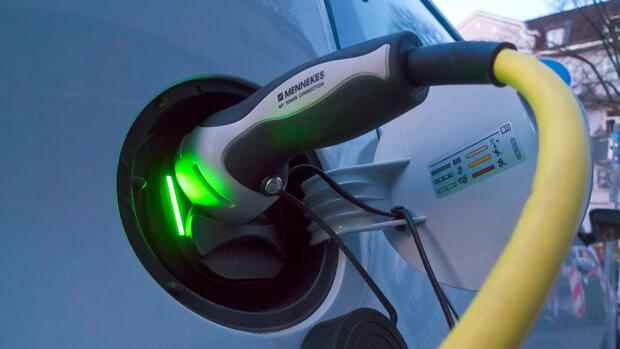Berlin Anyone who buys an electric car today usually wants to support the switch to renewable energies. After all, only potentially green electricity ends up in the battery instead of fossil fuels. But e-cars will play a much larger role in the energy transition in the coming years.
“You can only think about the energy transition and mobility transition together,” said Elke Temme, business unit manager of the “Charging and Energy” division at Volkswagen Group Components, on Wednesday at the Handelsblatt Energy Summit in Berlin. “More renewable energies mean: more volatility in the grid. We need more storage, and we have that with electric cars.”
The problem: the higher the share of renewable energies in German electricity production, the more the amount of electricity fed into the grid fluctuates. A particularly large amount of electricity is generated on sunny, windy days – and particularly little on dark, windless days.
So if a lot of electricity is going into the grid, a lot should also be used – and the surplus should be stored for darker times. Electric cars are essential for this.
Top jobs of the day
Find the best jobs now and
be notified by email.
According to the federal government’s plans, the number of electric vehicles is to increase sharply in the coming years. In 2021, only 360,000 electric cars were newly registered in Germany. It was more than ever before. But for around 15 million electric cars to drive through Germany by 2030, as the coalition agreement envisages, the number would have to be more than four times as many each year.
The planned flood of electric cars is a great opportunity for manufacturers. Accordingly, Volkswagen now relies entirely on the Stromer. “The future of the car is electric. We don’t see any other technology for the passenger car,” said Temme. “We want to set up more than 18,000 fast charging points by 2025 to make it easier for customers to switch.”
“Electromobility is increasing at very specific points”
The rapidly increasing number of e-cars and charging stations is a major challenge for the German power grid – but also holds a lot of potential. The glut of e-cars can become a problem or a solution in the energy transition. Depending on how the network operators deal with it.
Cars can become a problem if a large number of vehicles want to charge electricity at the same time. This can overwhelm the power grids locally.
Markus Hilkenbach, head of the WSW Wuppertaler Stadtwerke, also warned at the energy summit: “Electric mobility is increasing at very specific points.” Therefore, the infrastructure must also be expanded at specific points. “I don’t think it will work completely without physical expansion and network reinforcement,” says Hilkenbach.
On the other hand, if it is possible to control the demand for electricity from the many e-cars, they can even support the grids. “In the future, the car will be part of the energy system,” says Elke Temme from Volkswagen Group Components. “It must then provide flexibility to the network operators.”
According to industry experts, the goal is for as many electric cars as possible to start charging when there is a lot of electricity available in the grid, for example because the wind is blowing strongly or because people currently need little electricity for other things. If, on the other hand, a lot of electricity is required, e-cars should automatically stop charging.
To increase the effect even further, cars with a full battery could even feed part of their electricity back into the grid. This is called “bidirectional charging”, i.e. charging in two different directions. “We are absolutely convinced that bidirectional charging is important in order to keep the costs of the energy transition under control,” says Temme.
“brains instead of copper”
Manufacturers like Volkswagen have to provide the necessary technology for bidirectional charging in electric cars. But the network operators also have to digitize their systems. Only intelligent systems can recognize when and how much electricity is being used and which batteries can be tapped at the moment.
A number of actors are already working on implementing this idea on a large scale. For example, Envision Digital Germany, German subsidiary of the international group Envision Digital from Singapore, which in turn belongs to the Chinese Envision Group. The group produces wind turbines, batteries and software all over the world.
More from the energy summit:
The German subsidiary focuses on software solutions for an intelligent charging infrastructure that is intended to stabilize the power grid. For this, Envision Digital uses its central product, the software EnOS. “150 million devices are now connected to it. With this platform we can intelligently control energy all over the world,” says Drazen Nikolic, Managing Director of Envision Digital Germany.
The Munich start-up GridX, majority owned by Eon, is also developing digital solutions for intelligent power grid control with the help of electric cars. The founder and CEO of GridX, Andreas Booke, said at the Handelsblatt energy summit that such a control is already technologically feasible today. “The technologies that we have today are able to switch flexibilities on or off in a matter of milliseconds.”
However, the regulations and incentives are currently problematic. “Network operators see a return on their investment by laying more copper,” says Booke. “We say: brains instead of copper. There must be incentives for network operators to install intelligent and digital systems.”
Hilkenbach from the Wuppertaler Stadtwerke also agrees. “Of course, avoiding grid expansion is economically the better option,” he said. From an economic point of view, however, the construction of an intelligent charging infrastructure is not yet worthwhile enough.
More: Charging without a tangle of cables: EnBW and Wien Energie are investing in new technology

